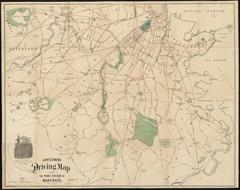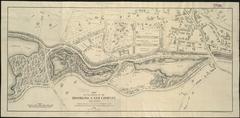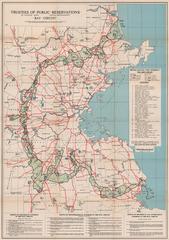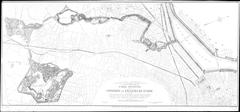
Emerald Necklace Boston: Comprehensive Guide to Visiting Hours, Tickets, and Historical Sites
Date: 14/06/2025
Introduction to the Emerald Necklace Boston
The Emerald Necklace is Boston’s renowned 1,100-acre network of interconnected parks, parkways, and waterways stretching approximately seven miles through the city and into Brookline. Conceived in the late 19th century by Frederick Law Olmsted—the father of American landscape architecture—the Emerald Necklace was designed as a visionary response to urban overcrowding and environmental degradation. Olmsted’s plan aimed to create a continuous “green ribbon” that would offer flood control, recreational space, and ecological resilience, while knitting together diverse neighborhoods and fostering social inclusion (Boston.gov, Olmsted.org).
The park system unites some of Boston’s most cherished public spaces, including Boston Common, the Public Garden, Back Bay Fens, Jamaica Pond, Arnold Arboretum, and Franklin Park. Each site boasts unique historical, cultural, and natural features, making the Emerald Necklace both the “green lungs” of Boston and a vibrant community resource. The Necklace continues to address environmental challenges, enrich urban life, and offer a wealth of recreational and educational opportunities (Emerald Necklace Conservancy, Urban History Project).
This guide provides up-to-date information on visiting hours, ticketing, accessibility, travel tips, and nearby attractions, ensuring visitors make the most of their Emerald Necklace experience. For the latest updates, events, and guided tours, consult the Emerald Necklace Conservancy and Boston Parks and Recreation.
Table of Contents
- History & Vision
- Development and Key Sites
- Social, Environmental, and Economic Significance
- Preservation and Restoration
- Visitor Information: Hours, Tickets, and Tips
- In-Depth Park Guides:
- Accessibility & Travel
- Events and Guided Activities
- Frequently Asked Questions (FAQ)
- Visuals and Media Resources
- Related Articles & Further Reading
- Conclusion and Call to Action
History & Vision
Boston’s Emerald Necklace emerged from 19th-century efforts to counteract the negative effects of rapid industrialization and population growth. Social reformers and city officials, inspired by Progressive Era ideals, envisioned parks as vital for public health, recreation, and social unity (Boston.gov, Urban History Project).
Frederick Law Olmsted was commissioned in 1878 to design a comprehensive park system. His vision centered on a U-shaped “necklace” of green spaces, blending flood control and sanitation solutions with restorative landscapes accessible to all social classes (Olmsted.org).
Development and Key Sites
Construction of the Emerald Necklace took place between 1878 and 1896, transforming marshlands and undeveloped areas into a cohesive chain of parks. Olmsted’s collaborators included Charles Eliot, John Charles Olmsted, and Frederick Law Olmsted Jr. (Olmsted.org). The final link to Boston Harbor (the Dorchesterway) was never completed (Wikipedia).
Major Parks and Landmarks
- Boston Common: The oldest public park in America, a central gathering place since the 1630s.
- Public Garden: The nation’s first public botanical garden, famed for its Victorian design and swan boats.
- Commonwealth Avenue Mall: A tree-lined promenade with monuments and statues.
- Back Bay Fens: A reclaimed marshland, now a managed wetland with gardens and community plots.
- The Riverway: A scenic corridor along the Muddy River with shaded paths and stone bridges.
- Olmsted Park: Features tranquil ponds and woodlands, ideal for nature walks and relaxation.
- Jamaica Pond: Boston’s largest freshwater body, popular for boating and community events.
- Arnold Arboretum: North America’s oldest public arboretum, renowned for its plant collections.
- Franklin Park: The largest park in the Necklace, home to the Franklin Park Zoo and extensive woodlands (Emerald Necklace Conservancy).
Social, Environmental, and Economic Significance
The Emerald Necklace addressed pressing urban problems by improving flood control, air quality, and providing wildlife habitats (Olmsted.org). Olmsted’s parks were conceived as democratic spaces, welcoming people from all backgrounds and fostering a sense of community (Urban History Project).
The park system also spurred economic benefits, raising property values in adjacent neighborhoods and attracting investment (Urban History Project).
Preservation and Restoration
By the mid-20th century, some parks faced neglect and underfunding. In 1971, the system was listed on the National Register of Historic Places, and the Emerald Necklace Conservancy was founded in 1998 to oversee stewardship and restoration (Wikipedia). The Muddy River Restoration Project (2014–2023) exemplifies ongoing efforts to restore ecological health, daylight river sections, and improve flood resilience (Olmsted.org).
Visitor Information: Hours, Tickets, and Tips
- General Hours: Most parks are open daily from dawn to dusk.
- Admission: Free for general park access. Fees apply to specific attractions (e.g., Franklin Park Zoo, boat rentals).
- Guided Tours: Offered seasonally by the Conservancy. Advance reservations recommended.
- Best Times to Visit: Spring and fall for mild weather and colorful foliage.
- Accessibility: Many paths accommodate wheelchairs and strollers; check official resources for details.
- Parking and Transit: Limited street parking; use MBTA Green and Orange Lines, or local buses for convenient access.
- Events: Seasonal festivals, concerts, and educational programs—check the Emerald Necklace Conservancy events calendar.
In-Depth Park Guides
Charlesgate Park
Marking the northern gateway to the Necklace, Charlesgate Park links to the Charles River Esplanade. It features historic bridges, mature trees, and ongoing restoration efforts to improve accessibility (Emerald Necklace Conservancy).
Hours: Dawn to dusk.
Back Bay Fens
A reclaimed marshland, the Fens today features:
- Kelleher Rose Garden: Over 1,500 roses, open seasonally.
- Fenway Victory Gardens: The oldest intact victory gardens in the U.S.
- Japanese Temple Bell, puddingstone bridges, and public art.
The park hosts events like guided history walks and Fenway Porchfest (Emerald Necklace Conservancy Events).
Hours: Dawn to dusk.
The Riverway
A narrow, wooded park along the Muddy River, the Riverway provides scenic walking and biking paths and is a key wildlife corridor (Great Runs).
Hours: Dawn to dusk.
Olmsted Park
Featuring Leverett, Willow, and Ward’s Ponds, Olmsted Park is ideal for birdwatching, picnics, and peaceful walks (Great Runs).
Hours: Dawn to dusk.
Jamaica Pond
Boston’s largest natural pond offers:
- Boating: Rentals available Memorial Day to early October (fees apply).
- Fishing: Stocked pond.
- Events: Community regattas, concerts, and stewardship days (Emerald Necklace Conservancy Events).
Hours: Dawn to dusk.
Arnold Arboretum
A 281-acre living museum managed by Harvard University, with:
- Lilac Sunday: Celebrated each May.
- Miles of accessible trails (Great Runs).
- Educational tours and programs.
Hours: 7:00 AM to sunset.
Admission: Free.
Franklin Park
The largest park in the system, Franklin Park features:
- Franklin Park Zoo: Over 220 animal species (separate admission).
- Golf Course: Public 18-hole course.
- Woodlands, meadows, and sports facilities.
- Major community events (Emerald Necklace Conservancy Events).
Hours: Dawn to dusk; zoo hours vary (Franklin Park Zoo).
Accessibility & Travel
- MBTA Green and Orange Lines: Provide access near most parks.
- Cycling: Dedicated lanes and improved crossings.
- Wheelchair Accessibility: Many main trails are paved; check individual park details.
- Restrooms: Available seasonally at select sites.
- Maps: Downloadable from the Conservancy website.
Events and Guided Activities
The Emerald Necklace Conservancy offers:
- Free public walks and educational programs
- Volunteer stewardship days
- Partner events with nearby museums
Registration is often required. See event listings.
Frequently Asked Questions (FAQ)
Q: What are the Emerald Necklace visiting hours?
A: Most parks are open from dawn to dusk, with some facilities (e.g., Franklin Park Zoo, Arnold Arboretum) having specific hours.
Q: Are tickets required for entry?
A: General park access is free. Some attractions, like the zoo or boat rentals, require tickets or fees.
Q: Is the Emerald Necklace accessible for people with disabilities?
A: Many trails and amenities are wheelchair accessible. Check specific park websites for details.
Q: Can I bring my dog?
A: Dogs are allowed if leashed. Follow posted park rules.
Q: How do I get there by public transport?
A: MBTA Green and Orange Lines, plus several bus routes, serve various entry points.
Visuals and Media Resources
Explore high-quality images and interactive maps on the Emerald Necklace Conservancy gallery, featuring park highlights, seasonal views, and community events. Use alt text with keywords such as “Emerald Necklace Boston parks” and “Boston historical sites.”
Related Articles & Further Reading
- Boston.gov: Emerald Necklace Overview
- Olmsted.org: Spotlight on Boston’s Emerald Necklace
- Urban History Project: Boston’s Emerald Necklace
- Emerald Necklace Wikipedia
- Emerald Necklace Conservancy: Park Overview
- Emerald Necklace Conservancy: Visitor Information
- Emerald Necklace Conservancy: Advocacy & Restoration
Conclusion and Call to Action
The Emerald Necklace is a living legacy of urban vision, ecological stewardship, and community spirit. Its parks and waterways, designed to address the challenges of urbanization, now offer Boston residents and visitors a sanctuary for recreation, education, and connection to nature. With free general access, convenient public transit, accessible trails, and engaging events, the Necklace is truly open to all.
Begin your journey at the Emerald Necklace Conservancy website for the latest visitor information, maps, and events. Download the Audiala app for interactive tours and real-time updates, and join the conversation on social media using #EmeraldNecklaceBoston.






































































































































